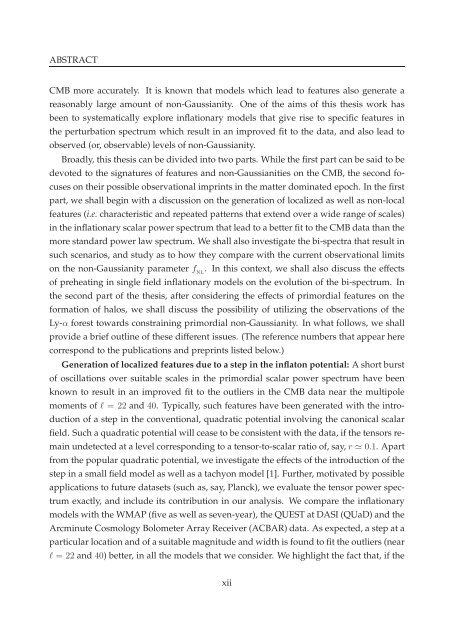PHYS08200605006 D.K. Hazra - Homi Bhabha National Institute
PHYS08200605006 D.K. Hazra - Homi Bhabha National Institute
PHYS08200605006 D.K. Hazra - Homi Bhabha National Institute
Create successful ePaper yourself
Turn your PDF publications into a flip-book with our unique Google optimized e-Paper software.
ABSTRACT<br />
CMB more accurately. It is known that models which lead to features also generate a<br />
reasonably large amount of non-Gaussianity. One of the aims of this thesis work has<br />
been to systematically explore inflationary models that give rise to specific features in<br />
the perturbation spectrum which result in an improved fit to the data, and also lead to<br />
observed (or, observable) levels of non-Gaussianity.<br />
Broadly, this thesis can be divided into two parts. While the first part can be said to be<br />
devoted to the signatures of features and non-Gaussianities on the CMB, the second focuses<br />
on their possible observational imprints in the matter dominated epoch. In the first<br />
part, we shall begin with a discussion on the generation of localized as well as non-local<br />
features (i.e. characteristic and repeated patterns that extend over a wide range of scales)<br />
in the inflationary scalar power spectrum that lead to a better fit to the CMB data than the<br />
more standard power law spectrum. We shall also investigate the bi-spectra that result in<br />
such scenarios, and study as to how they compare with the current observational limits<br />
on the non-Gaussianity parameter f NL<br />
. In this context, we shall also discuss the effects<br />
of preheating in single field inflationary models on the evolution of the bi-spectrum. In<br />
the second part of the thesis, after considering the effects of primordial features on the<br />
formation of halos, we shall discuss the possibility of utilizing the observations of the<br />
Ly-α forest towards constraining primordial non-Gaussianity. In what follows, we shall<br />
provide a brief outline of these different issues. (The reference numbers that appear here<br />
correspond to the publications and preprints listed below.)<br />
Generation of localized features due to a step in the inflaton potential: A short burst<br />
of oscillations over suitable scales in the primordial scalar power spectrum have been<br />
known to result in an improved fit to the outliers in the CMB data near the multipole<br />
moments of l = 22 and 40. Typically, such features have been generated with the introduction<br />
of a step in the conventional, quadratic potential involving the canonical scalar<br />
field. Such a quadratic potential will cease to be consistent with the data, if the tensors remain<br />
undetected at a level corresponding to a tensor-to-scalar ratio of, say,r ≃ 0.1. Apart<br />
from the popular quadratic potential, we investigate the effects of the introduction of the<br />
step in a small field model as well as a tachyon model [1]. Further, motivated by possible<br />
applications to future datasets (such as, say, Planck), we evaluate the tensor power spectrum<br />
exactly, and include its contribution in our analysis. We compare the inflationary<br />
models with the WMAP (five as well as seven-year), the QUEST at DASI (QUaD) and the<br />
Arcminute Cosmology Bolometer Array Receiver (ACBAR) data. As expected, a step at a<br />
particular location and of a suitable magnitude and width is found to fit the outliers (near<br />
l = 22 and 40) better, in all the models that we consider. We highlight the fact that, if the<br />
xii
















